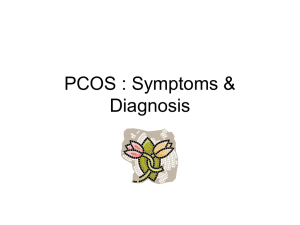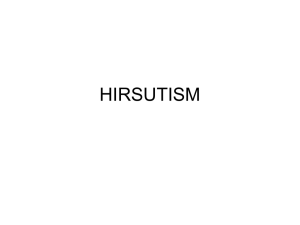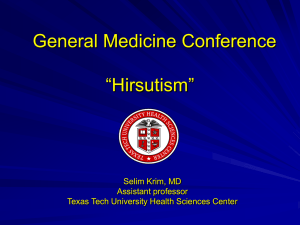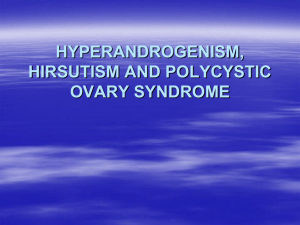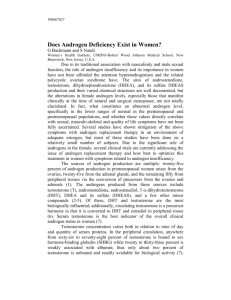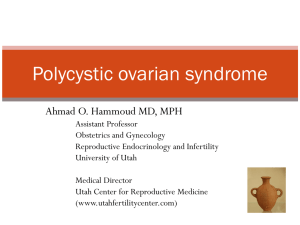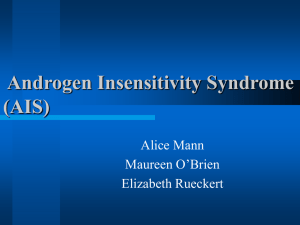Fine adult hair covering body Terminal hair
advertisement
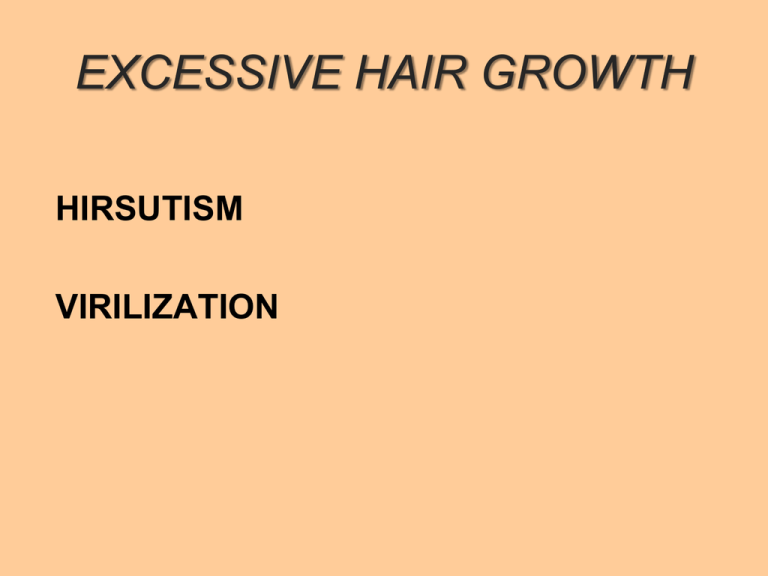
EXCESSIVE HAIR GROWTH HIRSUTISM VIRILIZATION Hair typeS • Lanugo : Body hair seen in newborn • Vellus : Fine adult hair covering body • Terminal hair : Thick pigmented hair of scalp and pubic area Hair cycleS • Anagen : Growth influenced by disorders • Catagen : rapid involution • Telogen : Quiescent Eyebrows , eyelashes , vellus hairs androgen-insensitive axillary and pubic areas sensitive to low levels of androgens scalp region androgens cause scalp hairs to spend less time in anagen HIRSUTISM EXCESSIVE COARSE (TERMINAL)HAIR. IN PATTERN NOT NORMAL IN FEMALE . ( facial , chest , upper abdominal hair) HYPERTRICHOSIS EXCESS NORMAL DISTRIBUTION and NORMAL PATTERN OF medication such as antiepileptics Hyperthyroidism anorexia nervosa VIRILIZATION IN severe pathologic condition , malignancy FRONTOTEMPORAL BALDING DEPPENING OF VOICE DECREASED BREAST SIZE CLITORAL HYPERTROPHY INCREASED MUSCLE MASS AMENORREA / OLIGOMENORRHEA androgen levels and quantity of hair growth is not parrarel variability in end-organ sensitivity. Genetic factors ethnic background dark-haired individuals EXCESS REPONSIVITY TO ANDROGEN TESTOSTERONE in target receptors 5-ALPHA –REDUCTASE 1 DIHIDROTESTOSTERONE Excessive response of receptor to DHT due to mutation in gene ovaries and adrenal glands normally contribute equally to androgen production. Gonadal hyperandrogenism Polycystic ovary syndrom insulin resistance Syndrom Ovarian neoplasm Adrenal hyperandrogenism Congenital adrenal hyperplasia (nonclassic and classic) Cushing's syndrome Adrenal neoplasms Other endocrine disorders Hyperprolactinemia Acromegaly thyroid dis. Peripheral androgen overproduction Obesity Idiopathic Pregnancy-related hyperandrogenism Hyperreactio luteinalis Thecoma of pregnancy Drugs Androgens oral contraceptives containing androgenic progestins Minoxidil Phenytoin Diazoxide Cyclosporine ADRENAL ANDROGEN EXCESS 21 alpha Hydroxylase defieiency 11-beta-Hydroxylase deficiency 3-beta-dehydrogenase deficiency *Classical forms usually presented in neonatal period as ambiguous genitalia *Nonclassic forms are linked with hirsutism. Drugs & Exogenous Hormones variety of drugs decrease SHGB, resulting in increased levels of free T Androgens Corticosteroids Minoxidil Phenytoin diazoxide cyclosporin APPROACH TO DIAGNOSIS Careful history Onset and progression Family history medications Precocious puberty suggests adrenal enzyme defect Physical Exam • Hair pattern type,distribution ,quantity (F&G) • acne • Virilization • Cushingoid features, galactorrhea , acromegal… • Acanthosis nigricans (in PCOS) • Wt , ht , BP • Tanner staging • Ovarian masses Evaluation of Hirsutism 1. Total testosterone & or free 2. DHEAS DHEAS adrenal source CAH or Cushings T , DHEA-S normal or minimally elevated Ovarian source Pelvice U/S r/o tumor Rapid Onset Virilization T>2ng/mL indicate ovarian neoplasm A baseline plasma total testosterone level (>3.5 ng/mL) usually indicates a virilizing tumor (>2 ng/mL) is suggestive. nl=1 A basal DHEAS level (>7000 µg/L) nl=2500suggests an adrenal tumor. CT or MRI for adrenal mass. ultrasound may help to identify an ovarian mass. treatment Management Estrogen effective 20% • Reduces LH so ovarian androgen • increased SHBG • competition at the cellular level for binding to androgen receptor • lower DHEA ( with lower ACTH ?!) Progestins vary in suppressive effect on SHBG levels so in androgenic potential. Ethynodiol diacetate low androgenic potential Norgestimate nonandrogenic. Drospirenone analogue of spironolactone (anti mineralocorticoid) & antiandrogenic Ocp contraindicated • history of thromboemboli • increased risk of breast or other estrogen-dependent cancers . relative contraindication smokers hypertension history of migraine SIPRONOLACTONE: • Androgen receptors • Androgen biosynthesis • metabolic clearance of teststerone ( Testosterone Estrogen ) Spironolactone + OC is well established regimen BP low, K low, female feature in male fetus , irregular mens Cyproterone acetate •Competitive inhibition of binding testosterone and DHT to androgen receptor. •Clearance of testosterone by inducing hepatic enzymes Cyproterone (50 to 100 mg) is given on days 1 to 15 and ethinyl estradiol (50 µg) is given on days 5 to 26 of the menstrual cycle. Side effects: irregular uterine bleeding, nausea, headache, fatigue, weight gain, and decreased libido. FLUTAMIDE : Blocks the androgen receptors .liver side effect KETOCONAZOLE: • liver toxicity Eflornithine cream (Vaniqa) long-term efficacy remains to be established.

